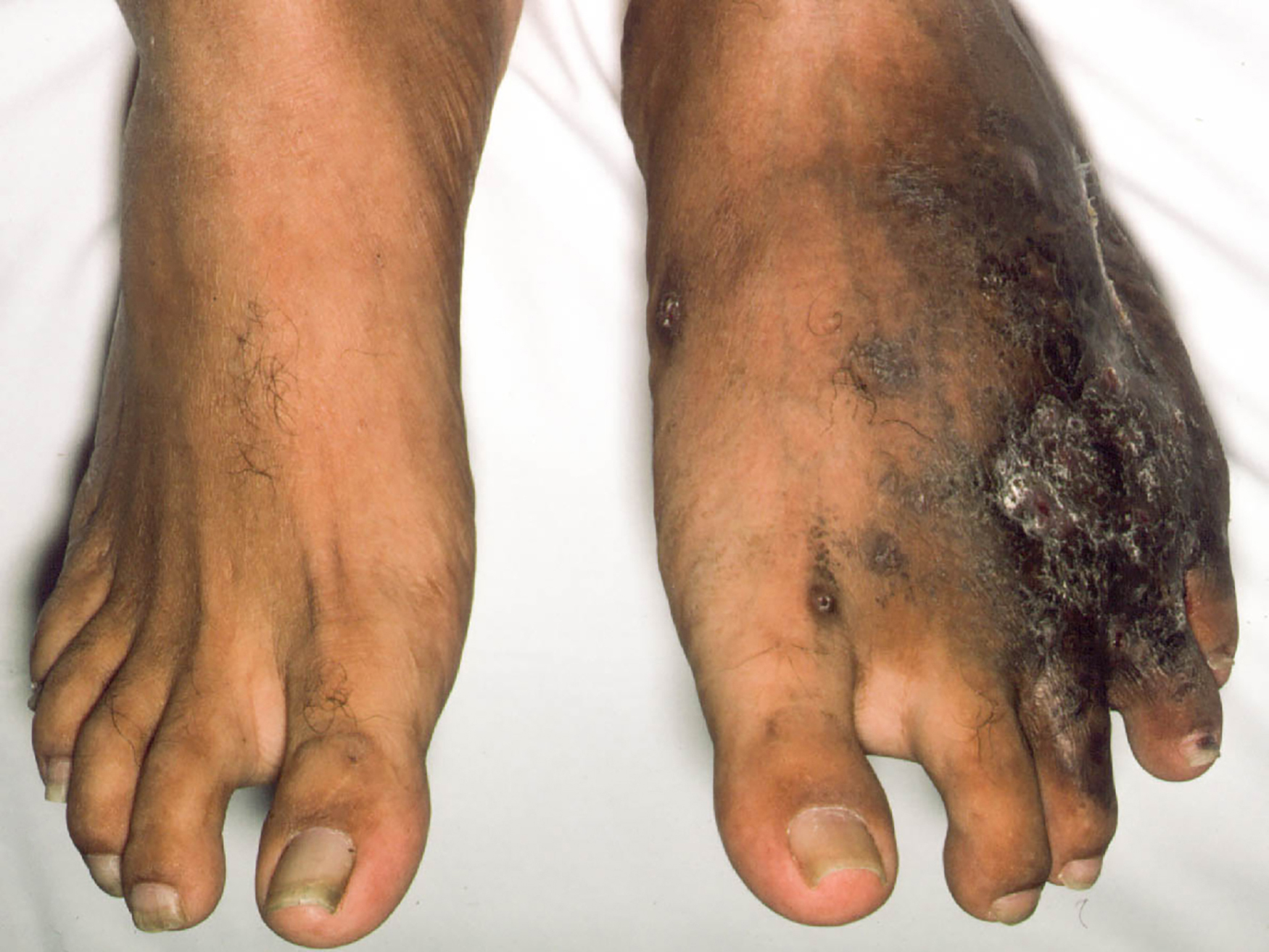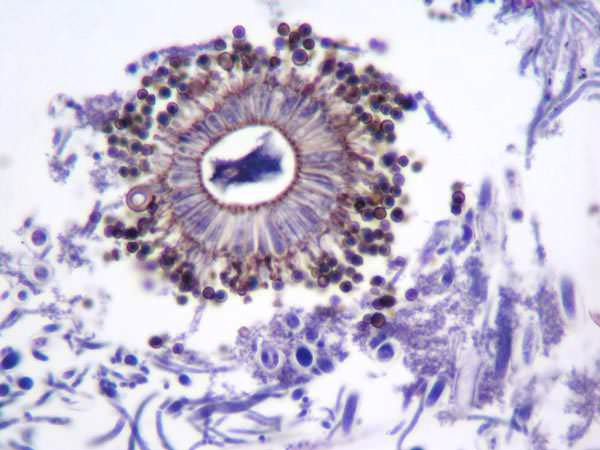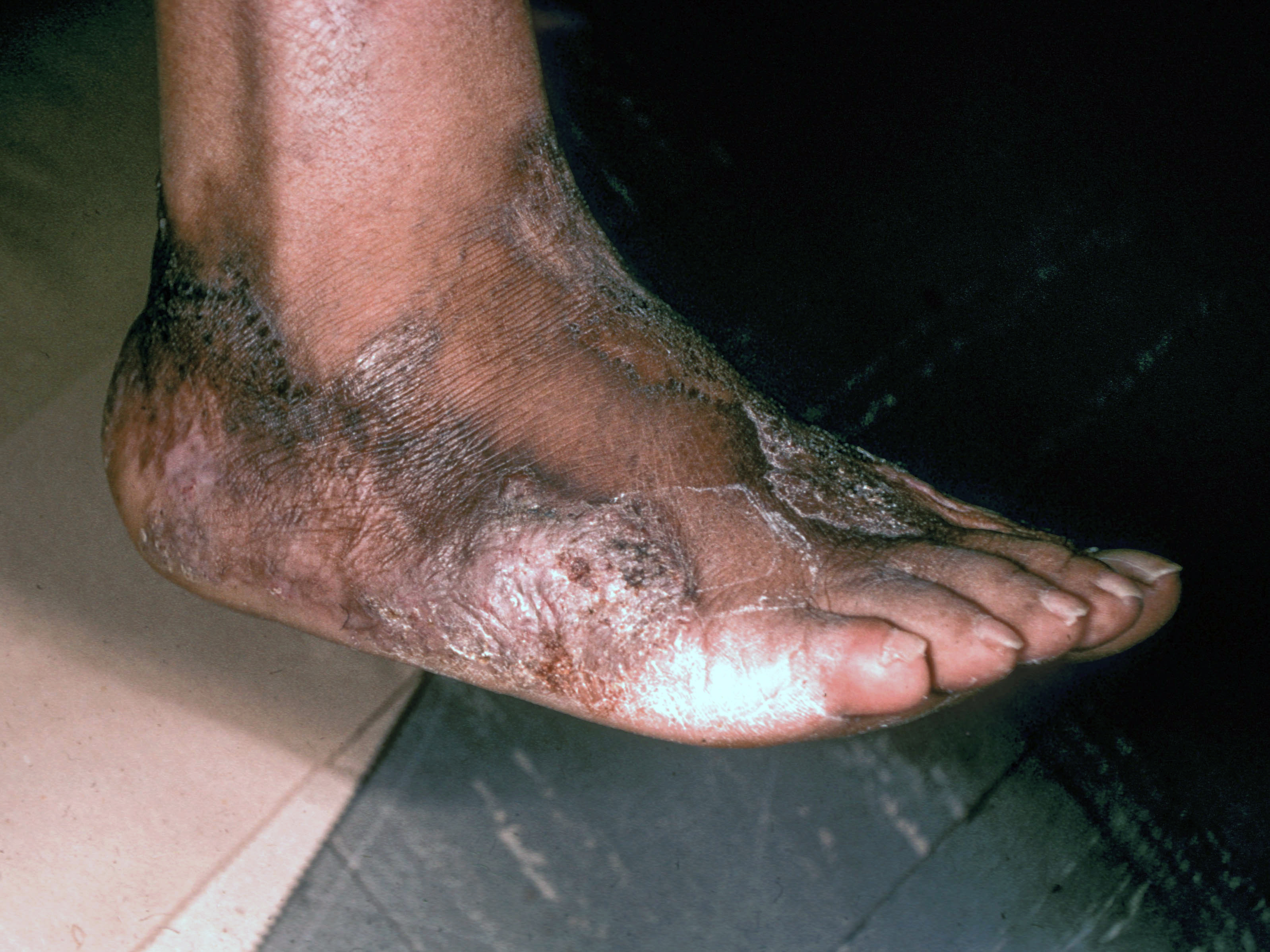[1]
Kuzucular E, Eren A, Isik E, Ozden F. Mycetoma (Madura foot): A Case Report of a Rare Tropical Disease in Turkey. The international journal of lower extremity wounds. 2023 Feb 22:():15347346231156642. doi: 10.1177/15347346231156642. Epub 2023 Feb 22
[PubMed PMID: 36814397]
Level 3 (low-level) evidence
[2]
Siddig EE, Nyuykonge B, Mhmoud NA, Abdallah OB, Bahar MEN, Ahmed ES, Nyaoke B, Zijlstra EE, Verbon A, Bakhiet SM, Fahal AH, van de Sande WWJ. Comparing the performance of the common used eumycetoma diagnostic tests. Mycoses. 2023 May:66(5):420-429. doi: 10.1111/myc.13561. Epub 2023 Jan 17
[PubMed PMID: 36583225]
[3]
Singh B, Gehlot R, Saxena M, Bharwani N, Raichandani K, Bhati M. An unusual presentation of mycetoma around knee joint as a subcutaneous mass - A case report. Journal of orthopaedic case reports. 2022 Oct:12(10):22-25. doi: 10.13107/jocr.2022.v12.i010.3350. Epub
[PubMed PMID: 36874900]
Level 3 (low-level) evidence
[4]
Bahar Moni AS, Hoque MM. Chronic Painless, Multiple Papulo-Nodular Skin Lesion at Foot Resembles Mycetoma Infection (Madura Foot): A Case Report. The international journal of lower extremity wounds. 2023 Sep:22(3):616-619. doi: 10.1177/15347346211030753. Epub 2021 Jul 5
[PubMed PMID: 34223771]
Level 3 (low-level) evidence
[5]
Kombo EB. [Uncommon signs of mycetoma]. The Pan African medical journal. 2019:34():163. doi: 10.11604/pamj.2019.34.163.20300. Epub 2019 Nov 26
[PubMed PMID: 32153703]
[6]
White EA, Patel DB, Forrester DM, Gottsegen CJ, O'Rourke E, Holtom P, Charlton T, Matcuk GR. Madura foot: two case reports, review of the literature, and new developments with clinical correlation. Skeletal radiology. 2014 Apr:43(4):547-53. doi: 10.1007/s00256-013-1751-z. Epub 2013 Oct 23
[PubMed PMID: 24150831]
[7]
Sawatkar GU, Wankhade VH, Supekar BB, Singh RP, Bhat DM, Tankhiwale SS. Mycetoma: A Common Yet Unrecognized Health Burden in Central India. Indian dermatology online journal. 2019 May-Jun:10(3):256-261. doi: 10.4103/idoj.IDOJ_358_18. Epub
[PubMed PMID: 31149567]
[8]
Relhan V, Mahajan K, Agarwal P, Garg VK. Mycetoma: An Update. Indian journal of dermatology. 2017 Jul-Aug:62(4):332-340. doi: 10.4103/ijd.IJD_476_16. Epub
[PubMed PMID: 28794542]
[9]
Foltz KD, Fallat LM. Madura foot: atypical finding and case presentation. The Journal of foot and ankle surgery : official publication of the American College of Foot and Ankle Surgeons. 2004 Sep-Oct:43(5):327-31
[PubMed PMID: 15480410]
Level 3 (low-level) evidence
[10]
Diongue K, Diallo MA, Sarr L, Seck MC, Bréchard L, Ndiaye M, Badiane AS, Ranque S, Ndiaye D. Pulmonary Madurella mycetomatis mycetoma secondary to knee eumycetoma, Senegal. PLoS neglected tropical diseases. 2021 Mar:15(3):e0009238. doi: 10.1371/journal.pntd.0009238. Epub 2021 Mar 25
[PubMed PMID: 33764976]
[11]
Ahmed AO, van Leeuwen W, Fahal A, van de Sande W, Verbrugh H, van Belkum A. Mycetoma caused by Madurella mycetomatis: a neglected infectious burden. The Lancet. Infectious diseases. 2004 Sep:4(9):566-74
[PubMed PMID: 15336224]
[12]
Olenski M, Halliday C, Gullifer J, Martinez E, Crowe A, Sheorey H, Darby J. A Case of Trauma-Induced Falciformispora lignatilis Eumycetoma in a Renal Transplant Recipient. Tropical medicine and infectious disease. 2021 Aug 3:6(3):. doi: 10.3390/tropicalmed6030144. Epub 2021 Aug 3
[PubMed PMID: 34449744]
Level 3 (low-level) evidence
[13]
Fahal AH. Mycetoma: a thorn in the flesh. Transactions of the Royal Society of Tropical Medicine and Hygiene. 2004 Jan:98(1):3-11
[PubMed PMID: 14702833]
[14]
Sahu BK, Nag HL. An Illustrative Report of Three Cases of Madura Foot with Diagnostic and Treatment Features. Journal of orthopaedic case reports. 2021 Nov:11(11):74-78. doi: 10.13107/jocr.2021.v11.i11.2522. Epub
[PubMed PMID: 35415109]
Level 3 (low-level) evidence
[15]
Abdelrahman M, Saad EA, Abdulla GM, Mohamed A. Reconstructive Surgery for Mycetoma: Is There a Need to Establish an Algorithm? Plastic and reconstructive surgery. Global open. 2019 Apr:7(4):e2197. doi: 10.1097/GOX.0000000000002197. Epub 2019 Apr 24
[PubMed PMID: 31321187]
[16]
Emmanuel P, Dumre SP, John S, Karbwang J, Hirayama K. Mycetoma: a clinical dilemma in resource limited settings. Annals of clinical microbiology and antimicrobials. 2018 Aug 10:17(1):35. doi: 10.1186/s12941-018-0287-4. Epub 2018 Aug 10
[PubMed PMID: 30097030]
[17]
Nenoff P, van de Sande WW, Fahal AH, Reinel D, Schöfer H. Eumycetoma and actinomycetoma--an update on causative agents, epidemiology, pathogenesis, diagnostics and therapy. Journal of the European Academy of Dermatology and Venereology : JEADV. 2015 Oct:29(10):1873-83. doi: 10.1111/jdv.13008. Epub 2015 Feb 27
[PubMed PMID: 25726758]
[18]
Sow D, Ndiaye M, Sarr L, Kanté MD, Ly F, Dioussé P, Faye BT, Gaye AM, Sokhna C, Ranque S, Faye B. Mycetoma epidemiology, diagnosis management, and outcome in three hospital centres in Senegal from 2008 to 2018. PloS one. 2020:15(4):e0231871. doi: 10.1371/journal.pone.0231871. Epub 2020 Apr 24
[PubMed PMID: 32330155]
[19]
Ahmed SA, El-Sobky TA, de Hoog S, Zaki SM, Taha M. A scoping review of mycetoma profile in Egypt: revisiting the global endemicity map. Transactions of the Royal Society of Tropical Medicine and Hygiene. 2023 Jan 3:117(1):1-11. doi: 10.1093/trstmh/trac085. Epub
[PubMed PMID: 36084235]
Level 2 (mid-level) evidence
[20]
Develoux M. Epidemiologic Aspects of Mycetoma in Africa. Journal of fungi (Basel, Switzerland). 2022 Nov 29:8(12):. doi: 10.3390/jof8121258. Epub 2022 Nov 29
[PubMed PMID: 36547591]
[21]
Hulin M, Lamoureux C, Sainte-Rose V, Drak Alsibai K, Demar M, Couppie P, Blaizot R. Fungal and bacterial mycetoma in migrants from Haiti: A case series. Travel medicine and infectious disease. 2023 Mar-Apr:52():102530. doi: 10.1016/j.tmaid.2022.102530. Epub 2022 Dec 17
[PubMed PMID: 36539021]
Level 2 (mid-level) evidence
[22]
Nyuykonge B, Siddig EE, Konings M, Bakhiet S, Verbon A, Klaassen CHW, Fahal AH, van de Sande WWJ. Madurella mycetomatis grains within a eumycetoma lesion are clonal. Medical mycology. 2022 Jul 29:60(7):. doi: 10.1093/mmy/myac051. Epub
[PubMed PMID: 35833294]
[23]
Abushouk A, Nasr A, Masuadi E, Allam G, Siddig EE, Fahal AH. The Role of Interleukin-1 cytokine family (IL-1β, IL-37) and interleukin-12 cytokine family (IL-12, IL-35) in eumycetoma infection pathogenesis. PLoS neglected tropical diseases. 2019 Apr:13(4):e0007098. doi: 10.1371/journal.pntd.0007098. Epub 2019 Apr 4
[PubMed PMID: 30946748]
[24]
Seyedmousavi S, Netea MG, Mouton JW, Melchers WJ, Verweij PE, de Hoog GS. Black yeasts and their filamentous relatives: principles of pathogenesis and host defense. Clinical microbiology reviews. 2014 Jul:27(3):527-42. doi: 10.1128/CMR.00093-13. Epub
[PubMed PMID: 24982320]
[25]
Fahal AH, el Toum EA, el Hassan AM, Mahgoub ES, Gumaa SA. The host tissue reaction to Madurella mycetomatis: new classification. Journal of medical and veterinary mycology : bi-monthly publication of the International Society for Human and Animal Mycology. 1995 Jan-Feb:33(1):15-7
[PubMed PMID: 7650573]
Level 3 (low-level) evidence
[26]
Samaila MO, Abdullahi K. Cutaneous manifestations of deep mycosis: an experience in a tropical pathology laboratory. Indian journal of dermatology. 2011 May:56(3):282-6. doi: 10.4103/0019-5154.82481. Epub
[PubMed PMID: 21772588]
[27]
Ansari F, Singh S, Bhardwaj A, Budania A, Bains A, Nalwa A, Khera S, Elhence P, Patel A, Yadav T, Khera P. Clinical triad with multi-biopsy histopathology as a reliable diagnostic marker of mycetomas: a retrospective review from a tertiary care center. International journal of dermatology. 2023 Jan:62(1):88-96. doi: 10.1111/ijd.16384. Epub 2022 Aug 28
[PubMed PMID: 36030528]
Level 2 (mid-level) evidence
[28]
Ben Tekaya A, Yosra G, Saidane O, Rouached L, Bouden S, Tekaya R, Mahmoud I, Abdelmoula L. Eumycotic mycetoma involving the right foot: A new Tunisian case. Clinical case reports. 2022 Sep:10(9):e6327. doi: 10.1002/ccr3.6327. Epub 2022 Sep 12
[PubMed PMID: 36172334]
Level 3 (low-level) evidence
[29]
Siddig EE, Ahmed A, Hassan OB, Bakhiet SM, Verbon A, Fahal AH, van de Sande WWJ. Using a Madurella mycetomatis-specific PCR on grains obtained via non-invasive fine-needle aspirated material is more accurate than cytology. Mycoses. 2023 Jun:66(6):477-482. doi: 10.1111/myc.13572. Epub 2023 Feb 19
[PubMed PMID: 36740735]
[30]
Siddig EE, El Had Bakhait O, El Nour Hussein Bahar M, Siddig Ahmed E, Bakhiet SM, Motasim Ali M, Babekir Abdallah O, Ahmed Hassan R, Verbon A, van de Sande WWJ, Fahal AH. Ultrasound-guided fine-needle aspiration cytology significantly improved mycetoma diagnosis. Journal of the European Academy of Dermatology and Venereology : JEADV. 2022 Oct:36(10):1845-1850. doi: 10.1111/jdv.18363. Epub 2022 Jul 6
[PubMed PMID: 35748131]
[31]
Sonone PP, Hiwale KM. Histopathological Diagnosis of Eumycetoma With Paraspinal Sinuses: A Rare Case Report. Cureus. 2022 Sep:14(9):e29634. doi: 10.7759/cureus.29634. Epub 2022 Sep 26
[PubMed PMID: 36320972]
Level 3 (low-level) evidence
[32]
van de Sande WW, Fahal AH, Goodfellow M, Mahgoub el S, Welsh O, Zijlstra EE. Merits and pitfalls of currently used diagnostic tools in mycetoma. PLoS neglected tropical diseases. 2014 Jul:8(7):e2918. doi: 10.1371/journal.pntd.0002918. Epub 2014 Jul 3
[PubMed PMID: 24992636]
[33]
Sen A, Pillay RS. Case report: Dot-in-circle sign - An MRI and USG sign for "Madura foot". The Indian journal of radiology & imaging. 2011 Oct:21(4):264-6. doi: 10.4103/0971-3026.90684. Epub
[PubMed PMID: 22223936]
Level 3 (low-level) evidence
[34]
Bentaleb D, Mahdar I, Noureddine L, Mellouki A, Sabiri M, Lembarki G, Essodegui F, Regragui M. Diagnostic imaging of foot mycetomas: A report on two cases. Radiology case reports. 2022 May:17(5):1817-1823. doi: 10.1016/j.radcr.2022.02.081. Epub 2022 Mar 29
[PubMed PMID: 35369545]
Level 3 (low-level) evidence
[35]
Bahar ME, Bakheet OELH, Fahal AH. Mycetoma imaging: the best practice. Transactions of the Royal Society of Tropical Medicine and Hygiene. 2021 Apr 14:115(4):387-396. doi: 10.1093/trstmh/traa178. Epub
[PubMed PMID: 33537774]
[36]
Welsh O, Al-Abdely HM, Salinas-Carmona MC, Fahal AH. Mycetoma medical therapy. PLoS neglected tropical diseases. 2014 Oct:8(10):e3218. doi: 10.1371/journal.pntd.0003218. Epub 2014 Oct 16
[PubMed PMID: 25330342]
[37]
Venugopal PV, Venugopal TV. Treatment of eumycetoma with ketoconazole. The Australasian journal of dermatology. 1993:34(1):27-9
[PubMed PMID: 8240184]
[38]
Paugam A, Tourte-Schaefer C, Keïta A, Chemla N, Chevrot A. Clinical cure of fungal madura foot with oral itraconazole. Cutis. 1997 Oct:60(4):191-3
[PubMed PMID: 9347233]
[39]
Lacroix C, de Kerviler E, Morel P, Derouin F, Feuilhade de Chavin M. Madurella mycetomatis mycetoma treated successfully with oral voriconazole. The British journal of dermatology. 2005 May:152(5):1067-8
[PubMed PMID: 15888176]
[40]
Fahal AH, Rahman IA, El-Hassan AM, Rahman ME, Zijlstra EE. The safety and efficacy of itraconazole for the treatment of patients with eumycetoma due to Madurella mycetomatis. Transactions of the Royal Society of Tropical Medicine and Hygiene. 2011 Mar:105(3):127-32. doi: 10.1016/j.trstmh.2010.11.008. Epub 2011 Jan 17
[PubMed PMID: 21247608]
[41]
Fahal A, Mahgoub el S, El Hassan AM, Abdel-Rahman ME. Mycetoma in the Sudan: an update from the Mycetoma Research Centre, University of Khartoum, Sudan. PLoS neglected tropical diseases. 2015 Mar:9(3):e0003679. doi: 10.1371/journal.pntd.0003679. Epub 2015 Mar 27
[PubMed PMID: 25816316]
[42]
Loulergue P, Hot A, Dannaoui E, Dallot A, Poirée S, Dupont B, Lortholary O. Successful treatment of black-grain mycetoma with voriconazole. The American journal of tropical medicine and hygiene. 2006 Dec:75(6):1106-7
[PubMed PMID: 17172376]
[43]
Negroni R, Tobón A, Bustamante B, Shikanai-Yasuda MA, Patino H, Restrepo A. Posaconazole treatment of refractory eumycetoma and chromoblastomycosis. Revista do Instituto de Medicina Tropical de Sao Paulo. 2005 Nov-Dec:47(6):339-46
[PubMed PMID: 16553324]
[44]
Castro LG, Piquero-Casals J. Clinical and mycologic findings and therapeutic outcome of 27 mycetoma patients from São Paulo, Brazil. International journal of dermatology. 2008 Feb:47(2):160-3. doi: 10.1111/j.1365-4632.2008.03447.x. Epub
[PubMed PMID: 18211487]
[45]
N'diaye B, Dieng MT, Perez A, Stockmeyer M, Bakshi R. Clinical efficacy and safety of oral terbinafine in fungal mycetoma. International journal of dermatology. 2006 Feb:45(2):154-7
[PubMed PMID: 16445509]
[46]
Ramírez Soto MC, Malaga G. Subcutaneous mycoses in Peru: a systematic review and meta-analysis for the burden of disease. International journal of dermatology. 2017 Oct:56(10):1037-1045. doi: 10.1111/ijd.13665. Epub 2017 Jul 3
[PubMed PMID: 28670680]
Level 1 (high-level) evidence
[47]
Pang KR, Wu JJ, Huang DB, Tyring SK. Subcutaneous fungal infections. Dermatologic therapy. 2004:17(6):523-31
[PubMed PMID: 15571502]
[48]
Zeegelaar JE, Faber WR. Imported tropical infectious ulcers in travelers. American journal of clinical dermatology. 2008:9(4):219-32
[PubMed PMID: 18572973]
[49]
Seas C, Legua P. Mycetoma, chromoblastomycosis and other deep fungal infections: diagnostic and treatment approach. Current opinion in infectious diseases. 2022 Oct 1:35(5):379-383. doi: 10.1097/QCO.0000000000000870. Epub 2022 Aug 3
[PubMed PMID: 35942857]
Level 3 (low-level) evidence
[50]
Köhler JR, Hube B, Puccia R, Casadevall A, Perfect JR. Fungi that Infect Humans. Microbiology spectrum. 2017 Jun:5(3):. doi: 10.1128/microbiolspec.FUNK-0014-2016. Epub
[PubMed PMID: 28597822]
[51]
Aissat FZ, Denning DW. Fungal infections in Algeria. Mycoses. 2023 Jul:66(7):594-603. doi: 10.1111/myc.13585. Epub 2023 Apr 2
[PubMed PMID: 37005355]
[52]
Tomczyk S, Deribe K, Brooker SJ, Clark H, Rafique K, Knopp S, Utzinger J, Davey G. Association between footwear use and neglected tropical diseases: a systematic review and meta-analysis. PLoS neglected tropical diseases. 2014:8(11):e3285. doi: 10.1371/journal.pntd.0003285. Epub 2014 Nov 13
[PubMed PMID: 25393620]
Level 1 (high-level) evidence
[53]
Morand JJ. [Foot health in the tropics]. Medecine tropicale : revue du Corps de sante colonial. 2008 Apr:68(2):111-8
[PubMed PMID: 18630042]
[54]
Ray A, Aayilliath K A, Banerjee S, Chakrabarti A, Denning DW. Burden of Serious Fungal Infections in India. Open forum infectious diseases. 2022 Dec:9(12):ofac603. doi: 10.1093/ofid/ofac603. Epub 2022 Dec 26
[PubMed PMID: 36589484]
[55]
Wadal A, Elhassan TA, Zein HA, Abdel-Rahman ME, Fahal AH. Predictors of Post-operative Mycetoma Recurrence Using Machine-Learning Algorithms: The Mycetoma Research Center Experience. PLoS neglected tropical diseases. 2016 Oct:10(10):e0005007. doi: 10.1371/journal.pntd.0005007. Epub 2016 Oct 31
[PubMed PMID: 27798643]
[56]
Maheshwari S, Figueiredo A, Narurkar S, Goel A. Madurella mycetoma--a rare case with cranial extension. World neurosurgery. 2010 Jan:73(1):69-71. doi: 10.1016/j.surneu.2009.06.014. Epub 2009 Oct 9
[PubMed PMID: 20452871]
Level 3 (low-level) evidence
[57]
Awad A, Alnaser A, Abd-Elmaged H, Abdallah R, Khougali HS. Eumycetoma Osteomyelitis Calcaneus in Adolescent; report of case and literature review. BMC infectious diseases. 2021 Sep 23:21(1):995. doi: 10.1186/s12879-021-06695-3. Epub 2021 Sep 23
[PubMed PMID: 34556037]
Level 3 (low-level) evidence
[58]
Fahal AH, Sabaa AH. Mycetoma in children in Sudan. Transactions of the Royal Society of Tropical Medicine and Hygiene. 2010 Feb:104(2):117-21. doi: 10.1016/j.trstmh.2009.07.016. Epub 2009 Aug 28
[PubMed PMID: 19716573]
[59]
Saleh R, Nong I, Guatama A, Putro GD, Azis HS. Long term follow-up of Maduromycosis treatment: A case review. International journal of surgery case reports. 2021 May:82():105956. doi: 10.1016/j.ijscr.2021.105956. Epub 2021 May 3
[PubMed PMID: 33984729]
Level 3 (low-level) evidence



